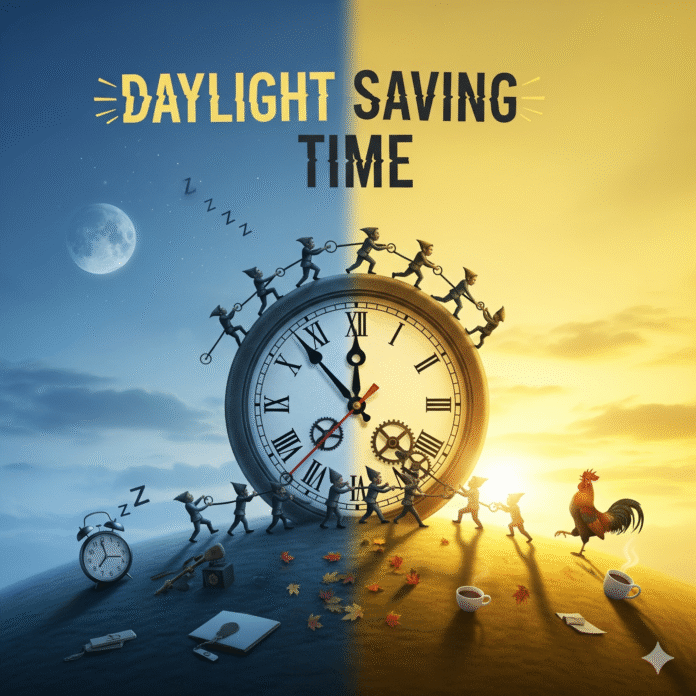Imagine having an extra hour of daylight for a summer evening walk, a barbecue, or just relaxing outdoors. Now, imagine a different scenario: twice a year, you have to manually adjust clocks across your home, car, and devices. This is the reality of Daylight Saving Time (DST), a practice observed by hundreds of millions globally.
DST is the annual practice of advancing clocks by one hour during warmer months—you “spring forward”—and then returning to standard time—you “fall back”—as winter nears. The core idea is to shift an hour of morning daylight, when most people are asleep, to the evening, when they are awake to use it. This tradition is a curious mix of history, science, and ongoing debate.
What Is the History Behind the Daylight Time Change?

The concept of shifting time to maximize daylight is centuries old, often mistakenly credited to Benjamin Franklin. However, the formal proposal came from George Hudson, a New Zealand entomologist, in 1895. He sought more evening daylight to pursue his hobby of collecting insects.
The practice gained traction during wartime:
- 1916: Germany was the first country to formally adopt DST to conserve fuel for the war effort during World War I.
- Other nations, including the United States, quickly followed suit with the goal of saving energy by reducing the need for artificial lighting in the evenings.
Who Observes Daylight Saving Time?
Despite its wide reach, DST is actually followed by a minority of countries—approximately 70 nations worldwide. Most are located in Europe and North America.

| Region | Participation and Exceptions |
| Europe | Most countries participate, though notable exceptions are Iceland, Belarus, and Russia. The European Union has discussed making DST permanent but has not reached a consensus. |
| North America | The United States and Canada largely observe DST. Major exceptions in the U.S. include Arizona (with the exception of the Navajo Nation) and Hawaii. In Canada, most of Saskatchewan and the Yukon also stay on a single time year-round. |
| Other Regions | A handful of countries in other regions observe it, including parts of Australia, New Zealand, Chile, Cuba, Haiti, and Egypt. The Southern Hemisphere observes a reversed schedule, “falling back” in April and “springing forward” in October. |
Many countries have abandoned DST, including Argentina, Brazil, China, Iraq, and Syria, often citing minimal energy savings and negative impacts on public life.
The Mechanics: How the Daylight Time Change Works
The biannual clock change follows a simple yet disruptive pattern, commonly summarized by the mnemonic: “Spring forward, fall back.”
The change is strategically implemented during the very early morning hours on a weekend to minimize disruption to work schedules and daily life.
1. Spring Forward (Start of DST)
- When: The transition typically occurs on the second Sunday in March (in North America).
- The Change: Clocks are advanced by one hour. For example, local time jumps from 2:00 a.m. to 3:00 a.m.
- Effect: This effectively creates a 23-hour day. People lose an hour of sleep but gain an hour of daylight in the evening for the next several months.
2. Fall Back (End of DST)
- When: The return to Standard Time occurs on the first Sunday in November (in North America).
- The Change: Clocks are moved backward by one hour. For example, local time reverts from 2:00 a.m. to 1:00 a.m.
- Effect: This creates a 25-hour day. The hour between 1:00 a.m. and 2:00 a.m. is essentially repeated, meaning people gain an hour of sleep and get more daylight in the morning as winter approaches.
The core result of both changes is that our civil time (the time on the clock) is shifted relative to solar time (the time defined by the sun’s position), allowing human schedules to align better with the extended daylight hours of the warmer seasons.
The Great Debate: Is Daylight Saving Time (DST) Still Relevant?
The relevance of DST is highly controversial, touching on energy, health, and public safety.
| Proponents Argue (Benefits) | Critics Argue (Drawbacks) |
| Public Safety & Economy: Studies suggest a decrease in traffic accidents and crime rates during DST due to more evening light. The extra hour also provides more time for outdoor activities, which can boost local economies. | Health Impacts: The abrupt biannual time change can disrupt circadian rhythms, leading to “social jet lag.” This is linked to health issues like fatigue, irritability, and even an increased risk of heart attacks and strokes. |
| Energy Savings (Historical): Historically, it aimed for a modest reduction in energy consumption by reducing the use of electric lights. | Minimal Energy Savings (Modern): The rise of air conditioning complicates this, with some studies showing minimal or even opposite energy effects as people use more energy to cool homes in the longer evening hours. |
The Future of DST
As the debate persists, the idea of a single, year-round time is gaining momentum across various states and countries. Eliminating the biannual switch would simplify life and avoid the health disruptions caused by the time change.
Whether you appreciate the extra evening daylight or dread the clock adjustment, Daylight Saving Time is a rich, debated tradition. As you prepare to “fall back,” take a moment to consider the long, winding road that brings us to this biannual time adjustment.
Relevant Reference Links
Official U.S. Rules and Background
- NIST: Daylight Saving Time Rules (National Institute of Standards and Technology) – Provides the official statutory dates and times for DST changes in the U.S., along with a technical explanation of how the time change is implemented.
- Congress.gov: Daylight Saving Time (DST) – Offers a detailed history of federal DST legislation, including the Uniform Time Act and the current status of proposals like the Sunshine Protection Act.
International Status and Policy
- Daylight saving time – Wikipedia – A comprehensive starting point that details the history, the mechanics of “spring forward, fall back,” and a list of countries and territories that observe or have abandoned DST.
- Finnish Government: Clocks go back on Sunday (EU Status) – An article that clarifies the complicated status of the European Union’s 2018 proposal to end seasonal time changes, explaining why EU member states still follow the biannual switch.
Health and Scientific Debate
- Johns Hopkins: 7 Things to Know About Daylight Saving Time – Explores the scientific evidence linking the time shift to adverse health effects, such as increased risk of heart attacks and traffic accidents, due to circadian rhythm disruption.
- Stanford Medicine: Study suggests most Americans would be healthier without daylight saving time – Discusses research that models the health effects of permanent Standard Time versus permanent DST, prioritizing the impact on sleep and public health.
Read more blogs at : Okjango.com


